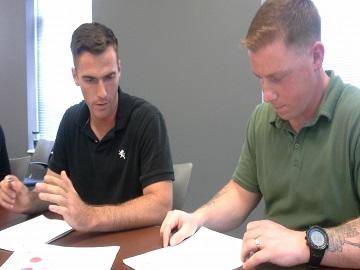
Section Branding
Header Content
Ft. Stewart Program Trains Soldiers To Stop Abuse, Sexual Assault
Primary Content

The Department of Defense estimates that nearly 19,000 service members were victims of sexual assault last year - most of them at the hands of other service members. Past efforts to address the problem have often focused on helping those victimized and prosecuting those responsible. But a new program at Fort Stewart (in Coastal Georgia) aims to stop assault before it happens. Soldiers are now learning an approach called bystander intervention.
Sometimes, it can be difficult for soldiers to come forward when something goes wrong. "For me, some of the things I feared was, well, what if he didn’t mean it that way?" says Sergeant Jamie Miller, of not reporting it when a superior officer sexually harassed her. "What if people look at me differently? What if they don’t believe me?"
She did finally tell her story, but only after she learned the same officer had assaulted another female soldier. "People didn’t respond well," she says. "Because this individual very much outranked us, all of those things that people are afraid of - they were true. There was a lot of distance put between us and some of the people within our company."
An investigation found the allegations were true, and Miller says the officer is no longer in the Army. Now, she’s part of the group bringing Bystander Intervention to Fort Stewart.
Sitting at tables arranged in a large U, pairs of soldiers are poring over stacks of paper. On each sheet, a scenario: a kid locked in a hot car, a sexual assault in progress. They’re going over how they’ll present these situations to their units. These soldiers have already completed a course on Bystander Intervention. Staff Sergeant Andrew Cordova says every detail matters as he gets ready to lead the training for others.
"The way they explain it is you want to scoop them up out of that scenario quickly so they’re not dwelling on it," he says, "and say if it was someone who was sexually assaulted, they have the chance to get up, walk out, compose themselves, and they can come back into the class."
Once they lay out each scenario, Cordova and Sergeant Anthony Costello will ask their fellow soldiers to talk it through: how would they react? Would they intervene? At what point does the situation become a problem, or an emergency? Costello says one of the goals is to get people out of a mindset called “groupthink.”
"Despite your own personal views," he says, "and your knowledge as a human being to know that something is inherently wrong with that, you go against what you know to be right, stay quiet, and keep your mouth shut."
Instead, Miller wants soldiers to intervene or get help when they see something that seems wrong. "We’re aiming towards a culture shift of people taking care of each other," she says. "Instead of running away from it, thinking of things as snitching, rather than saying no, ‘cause our unit doesn’t operate that way."
Civilian sexual assault advocates say widespread bystander training can bring about that kind of culture change. "If an example is made of a situation where somebody reported and things went right, that will then begin to be the standard of how scenarios are handled when it plays out on a military base," says Kesha Gibson-Carter of the Rape Crisis Center of the Coastal Empire.
Sergeant Costello also believes for bystander intervention to work, every unit has to take it seriously. "Do it quickly, just to say that we did it, and keep it going - if that happens, then it won’t be any more useful than any of the other millions of programs that the Army has come up with," he says.
The entire 3rd Infantry Division is set to complete the bystander training program by the end of October. Its creators say eventually, they’d like to see it in place throughout the Army.
Tags: Army, Fort Stewart, bystander intervention, Rape Crisis Center of the Coastal Empire, military sexual assault, domestic violence
Bottom Content

